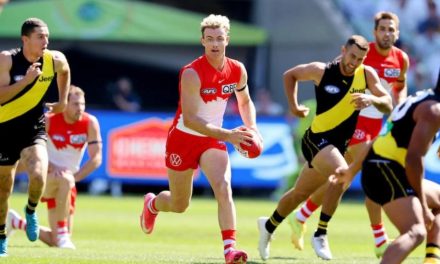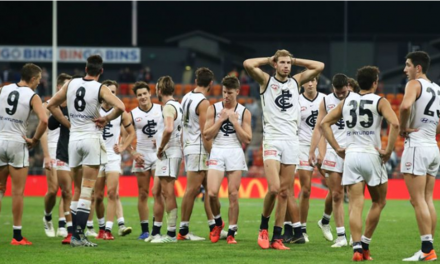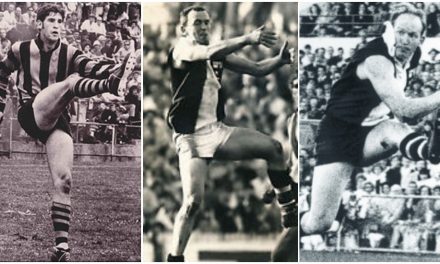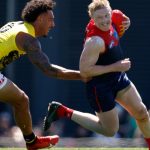Carlton coach Ron Barassi lays down the law to first-year Blue Brent Crosswell. Photo: www.blueseum.org
“Barassi’s Blues” is a new book that showcases a large number of photographs of the Carlton team that the legendary player and coach led to premiership success in 1968.
The book contains over 170 images, and many of them have been colourised. But more than a simple pictorial essay, it also provides analysis of how a premiership winning outfit was created by Carlton, delivering the club’s first flag for 21 years.
All football supporters ask the question: “What does my team need to obtain premiership success? Is there a formula?”
Well, in 1968, the formula for Carlton was (i) a significant improvement from at least four existing players; (ii) one player who thrived in a new playing position; and (iii) a newcomer/rookie who made an immediate impact.
The first category was filled by wingman Garry Crane, full-forward Brian Kekovich, ruckman Peter Jones and back pocket Robert Walls. The change of position came courtesy of Ian Collins, who moved from the centre to the back-pocket. And the third came in spectacular fashion in the shape of 17-year-old Brent Crosswell.
Crosswell’s story is one of the most fascinating in the history of the Carlton Football Club, outlined in the following extract from “Barassi’s Blues”.
Excluding the number one priority of needing a dominant centre half-forward, the biggest obstacle to Carlton’s success from 1965-67 was the lack of a consistently competitive centreman. Carlton’s solution to that problem came from an unusual source – the Tasmanian schoolboy team of Scotch College in Launceston. Former Blue Berkeley Cox can take the credit as the person who altered Carlton’s history by recommending the schoolboy footballer in Brent Crosswell to Barassi.
The six-time premiership coach, Norm Smith, in a pre-Round One commentary for “The Age”, showed scepticism as to what Crosswell could achieve when he stated: “Carlton’s newcomer, Brent Crosswell, in the centre, must be a good player, but it is a big jump from Tasmanian schoolboy football to the VFL.” For the rest of the season, the newspaper writers often referred to the rookie Crosswell as Carlton’s “schoolboy centreman”, yet there was not much scepticism about his ability after Round 1.
In his first game in the VFL, Crosswell was opposed to Geelong’s Denis Marshall, who had 66 games of experience behind him. On top of this, Marshall had represented Victoria in interstate football and was a Geelong best and fairest winner and a three-time Claremont best and fairest winner. The odds were against him, but Crosswell, aged 17, passed this first test against one of the best in the game, as he obtained 15 disposals compared to Marshall’s 23 disposals. “Brent Crosswell in the centre won’t meet too many opponents as brilliant as Denis Marshall. Young Crosswell never gave in and in the last half more than broke even with the brilliant Marshall,” said Footy Week’s Kevin Dynon.
A key insight into how good Crosswell was in the centre early in the season was provided by “The Herald’s” report for the Round Four match against Hawthorn. The experienced Hawthorn player Graham Arthur, the 200-game veteran, was initially selected as Crosswell’s opponent, yet in the third quarter Arthur left the match with a chest injury. That left the inexperienced Ted Johnson, in his 17th game, in a matchup on the “dangerous Crosswell”. It was not just Crosswell’s tally of 25 possessions in this match that impressed, but also the fact that he impacted the scoreboard. He scored a team-lifting goal in this match after he, “bolted from the centre” as The Herald’s John Craven put it.
PLEASE HELP US CONTINUE TO THRIVE BY BECOMING AN OFFICIAL FOOTYOLOGY PATRON. JUST CLICK THIS LINK.
Crosswell hit hot form again in the Round Five match against Footscray and “The Herald” referenced him being in “brilliant form in the centre. He showed great pace in making break-aways from opponents”. “Footy Week’s” journalist rated Crosswell best-on-ground in this match. It needs to be acknowledged that it was just his fifth game of VFL football as a 17-year-old schoolboy and he was already receiving such high plaudits. This rating as best on ground was a great achievement, especially as he was considered the best player over and above veterans such as John Nicholls and Serge Silvagni.

Carlton recruit Brent Crosswell goes through his paces at Blues’ training. Photo: ‘Barassi’s Blues’
Crosswell’s strong showings in matches continued until Round 17 versus South Melbourne. “Carlton’s ‘find’ of the season, Brent Crosswell, will be out of football for the next four weeks (due to a broken collarbone). Crosswell has been the Blues’ outstanding recruit this season, and has played in every game, either as a wingman or centreman,” stated “The Age’s” Percy Beames.
Although he missed the remaining home-and-away matches, Crosswell was rushed back in for the semi-final against Essendon despite not fully recovering from his injury. The footage clearly shows that he carried that shoulder injury throughout both matches. On more than one occasion, he tried tackling players without fully using his damaged shoulder, as he let his arm dangle to the side presumably so as not to cause any more structural damage. Nevertheless, he obtained 24 possessions and kicked two goals in the semi-final and accrued 20 possessions and kicked one goal in the grand final. This high possession tally coupled with his impact on the scoreboard provides a fair insight into the leading role he had in Carlton’s premiership success in 1968.
The Brent Crosswell story is one of the greatest recruitment stories in the history of the Carlton Football Club, if only for his young age at the time of his recruitment and for his quick adjustment to the demands of VFL football. An insight into what a remarkable player he was can be gauged by the fact that in the history of the VFL/AFL there have only been five players who have achieved premiership success at a younger age than Crosswell was in 1968. Crosswell was just 18 years, 51 days old when the premiership was won.
Although the 1968 season had a large Crosswell imprint, even greater recognition came to him due to his dominant role in the 1970 grand final. On reflection, Crosswell could be viewed as the second piece in a triumvirate of extraordinarily skilled players at Carlton. In 1967, Alex Jesaulenko had been recruited as a Carlton player, in 1968 it was Crosswell, and in 1969, the final piece was added with Syd Jackson. Three years in a row three players with sublime skills had been added to Carlton’s list. And then finally in the 1970 grand final we were fortunate enough to see all three display their football magic in one epic final. Crosswell, Jesaulenko and Jackson in the 1970 grand final – it has rarely, if at all, got better than that combination of football skill in the years since.
*’Barassi’s Blues’ can be ordered online HERE, and is also available from Dymocks in Camberwell.












I am interested in getting a copy of this book, please provide details.
John.schier@tollgroup.com
There’s a link to order a copy via mail at the bottom of the story.